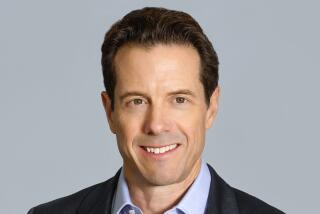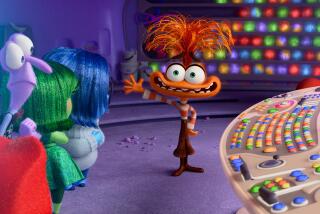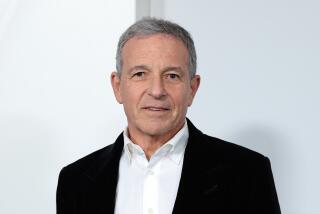Disney Pins Its Digital Future on Pixar Deal
With Tuesday’s agreement to buy Pixar Animation Studios, Walt Disney Co. intends to resurrect its ailing animation business -- the hallmark of its last -- while ensuring its place in Hollywood’s digital future.
The $7.4-billion all-stock deal for the computer animation pioneer aims to reestablish the creative and technological innovation that began with founder Walt Disney some 80 years ago.
“As I considered all the different possibilities of how to return Disney animation to greatness, it was clear to me that maintaining a relationship with Pixar was essential,” Disney Chief Executive Bob Iger said.
At the same time, however, Disney needs to make sure that as a media giant it doesn’t smother Pixar’s creative spirit.
The deal moves Iger a step closer to cementing his legacy as the man who brought Disney into the Digital Age. By forging the alliance with Pixar Chairman Steve Jobs, Disney is joined at the hip with one of technology’s most innovative executives.
It was Jobs’ Apple Computer Inc. that developed the iTunes online store that changed the way many people buy music by popularizing portable digital downloads. In October, Jobs and Iger announced that Apple’s newest iPod player -- a video version -- would debut with hit shows such as “Desperate Housewives” from Disney’s ABC network.
The deal would vault Jobs into the upper tier of media figures. Already one of the most influential executives in technology, Jobs would be Disney’s single largest shareholder, with a 7% stake worth about $3.5 billion. Jobs also would become a director of the Burbank entertainment giant.
Jobs said Tuesday that as he pondered Pixar’s future, he saw “a fork in the road” before he decided to sell to Disney. Jobs has controlled Pixar for 20 years, paying just $10 million in 1986 to buy the operation from director George Lucas.
“After a lot of soul searching and thinking, and of course getting to know Bob, this looked to be the most exciting path to Pixar’s future,” Jobs said.
For Disney, owning Pixar not only would help fatten Disney’s box-office coffers, but also would provide the studio with new characters to freshen its theme parks, consumer products and cable networks.
After a successful 15-year partnership in which Disney marketed and distributed such Pixar blockbusters as “The Incredibles,” “Finding Nemo” and the “Toy Story” films, the two companies nearly parted ways two years ago after Jobs clashed repeatedly with Iger’s predecessor, Michael Eisner.
Since becoming Disney’s CEO last October, Iger has made it a priority to mend the company’s fractured relationship with Jobs. The current arrangement was to end in June with the release of Pixar’s “Cars.”
In a conference call with analysts from Pixar’s Emeryville, Calif., headquarters, Iger and Jobs went to great pains to say that Pixar’s unique, artist-driven culture would be preserved after the companies combine.
Pixar’s less formal style is evident at its 16-acre, $90-million animation campus near Oakland. Employees work amid an outdoor amphitheater, a soccer field, swimming pool, basketball courts and volleyball nets. Inside its 220,000-square-foot headquarters, staffers ride scooters, taking breaks with games of pool, Ping-Pong and foosball.
In Pixar’s “pit,” animators show off their eccentricities and personalities by decorating their own work spaces. One artist built a castle. Another erected a tiki hut.
And then there is Pixar’s “Love Lounge,” a cozy cocktail bar in a crawlspace behind an animator’s office, where such visitors as Eisner have scrawled their names on the wall.
Jobs said the bulk of his conversations with Iger centered on the company’s free-spirited environment, which Iger pledged to preserve.
“I fully trust that as long as we can protect that environment and maintain it, we will continue to keep the best people,” Iger said.
But analyst Lowell Singer of S.G. Cowen & Co. remains skeptical. “I believe over time there is a risk that the culture of Pixar will change,” Singer said.
While Iger and Jobs were basking in the glow of their new union, the acquisition promised to have serious side effects for Disney’s core animation group and its chief, David Stainton.
Pixar’s creative guru John Lasseter and Pixar President Ed Catmull would take charge of Disney’s animation operation from Stainton, whose future role with Disney is unclear. Iger said that he and Disney Studios Chairman Dick Cook would meet with Stainton to explore the possibility of other Disney opportunities.
Lasseter, who worked as a Disney animator in the early 1980s, would be chief creative officer for both Disney animation and Pixar, which would remain separate units. He also would be the principal creative advisor at Walt Disney Imagineering, helping it design theme park attractions. Catmull would be president of both Pixar and Disney animation studios, reporting to Iger and Cook.
It is unknown how many of Disney’s 700 animation employees in Burbank would lose their jobs as a result of the combination. Iger declined to give specifics, but acknowledged that the transition would be unsettling.
“Any time there’s change like this in life, or at a company, there’s trepidation and it creates some anxiety -- that’s human nature,” Iger said in an interview, noting that he has been through such turmoil himself, at ABC when it was acquired by Capital Cities Communications Inc. and later by Disney. He said decisions about any layoffs in Disney’s animation unit would be made by Lasseter and Catmull.
Over the past three years Disney’s animation ranks have shrunk dramatically from more than 2,000 employees as the company turned out a string of costly box-office disappointments including “Home on the Range” and “Treasure Planet.”
For Disney, buying Pixar would instantly hasten its efforts to restore its once dominant role as animation king, a position it ceded in recent years to Pixar and other rivals such as DreamWorks Animation SKG Inc., which were focused on making the computer-generated films preferred by audiences. Disney was the last to jump on the digital bandwagon, finally abandoning the traditional hand-drawn cartoons on which it built its name with such hits as “The Lion King” and “Beauty and the Beast.” But while its first fully computer-animated release, “Chicken Little” was a modest hit, it fell far short of the hundreds of millions of dollars that Pixar hits have generated.
Some analysts said Iger’s decision to acquire Pixar was as potentially significant for Disney’s future as was Eisner’s decision to buy ABC more than a decade ago. “It’s certainly a very important moment,” said Harold Vogel, an independent media analyst with Vogel Capital. “This is his first major transaction and it will set the stage for at least the next couple of years.”
Pixar shares, which had risen more than 10% in recent weeks on takeover speculation, ended at $57.57 on Tuesday, down 70 cents, before the deal was announced. The stock rose to $59.10 in after-hours trading.
Disney shares rose 47 cents to $25.99 in regular trading and inched up to $26 after hours. The company agreed to pay 2.3 Disney shares for each Pixar share.
Not all analysts were upbeat about the deal, which is expected to close this summer. While they agree Pixar and Disney may be a natural strategic fit, they say, the combination carries risks.
“Disney is paying a very big price that really requires continued flawless execution from Pixar,” Singer said. “It makes this far from a slam dunk.”
The relationship between Pixar and Disney dates to 1986. At that time Pixar, which had only produced commercials and shorts, supplied technology to help modernize Disney’s animation division. In 1991, the companies struck their first deal to collaborate on computer-animated features.
Pixar’s first feature, 1995’s “Toy Story” was such a surprise hit that two years later Jobs renegotiated the deal with Disney, making Pixar an equal partner in the costs and spoils of all future films. Pixar went on to enjoy an unbroken string of hits with “A Bug’s Life,” “Toy Story 2,” “Monsters, Inc.,” “Finding Nemo” and “The Incredibles,” earning the company an unprecedented track record.
With such leverage, Jobs three years ago proposed a new, more lucrative deal for Pixar. The company would bankroll its own movies and retain all profits, paying Disney a fee to market and distribute them. While Pixar and Disney attempted to hammer out such an agreement amid a number of conflicts, the most significant being sequels, Jobs and Eisner continually locked horns and began taking shots at each other.
Right before the release of “Finding Nemo” in the summer of 2003, Eisner told the Disney board that Pixar might be in for a “reality check,” predicting that the movie would be less than a blockbuster. Instead, it was Pixar’s biggest hit.
Last year, Eisner called Pixar’s computer-generated human characters “pretty pathetic,” to which Jobs sarcastically responded, “Our films don’t stack up to ‘Atlantis: The Lost Empire,’ ‘Emperor’s New Groove’ or ‘Treasure Planet,’ ” referring to three Disney box-office disappointments.
Two years ago, frustrated over months of protracted negotiations to reach a new distribution deal with Disney, he stormed away from the talks, threatening to hook up with a rival studio.
At the time, Iger joined Eisner in taking a hard line on Disney’s future without Pixar, saying: “It would be nice to continue the relationship to infinity, but I think we’ve outgrown each other.”
But shortly after Eisner suddenly announced his plans to leave the company, Iger reconsidered and made a full-court press to woo Jobs back. Last fall, Iger proposed to Jobs that Disney buy Pixar.
“We both concluded that made a lot of sense,” Iger said.
*
(BEGIN TEXT OF INFOBOX)
Of mouse and men
Details of Disney’s deal to buy Pixar, announced Tuesday:
* Disney agrees to buy Pixar for $7.4 billion, all in Disney stock.
* Steve Jobs would be Disney’s largest individual shareholder and hold a seat on the board.
* Pixar’s John Lasseter and Ed Catmull would run Disney’s animation studio, replacing David Stainton, whose future with the company is unclear.
*
Box-office force
Worldwide box office of Pixar-Disney films, in billions:
“Toy Story”: $362.0
“A BugOs Life”: $363.4
“Toy Story 2”: $485.0
“Monsters, Inc.”: $525.4
“Finding Nemo”: $864.6
“The Incredibles”: $631.4
*
A long and profitable history
Walt Disney Co. said Tuesday that it would buy Pixar Animation Studios for $7.4 billion. The companies started working together in 1986. A look at their collaboration:
1986: Apple Computer co-founder Steve Jobs buys Pixar from director George Lucas for $10 million. Pixar begins developing animation software with Disney.
1991: Disney agrees to finance and distribute Pixar’s animated feature films.
1995: Disney releases Pixar’s “Toy Story,” which becomes the highest-grossing film of the year.
1997: Disney and Pixar announce a deal to make five additional movies together, for Disney to buy 5% of Pixar and to share costs and profit equally.
1998: “A Bug’s Life” breaks box-office records.
1999: “Toy Story 2” becomes a runaway hit, outgrossing the original.
2001: “Monsters, Inc.” becomes another blockbuster. Disney and Pixar argue over making “Toy Story 3,” a project still in limbo.
2002: The two companies announce that they will make three new films by 2005.
2003: After delivering the first of those films, “Finding Nemo,” Pixar is free to forge a partnership with another studio if it wishes.
2004: “The Incredibles” wins two Academy Awards. The release of the last movie in the existing contract, “Cars,” is postponed to June 2006.
2005: Pixar shares fall 10% in one day on news that sales of “The Incredibles” on DVD were less than expected.
Tuesday: After weeks of speculation, Disney confirms a $7.4-billion deal to buy Pixar.
*
Sources: Boxofficemojo.com, Times research. Graphics reporting by Penny Love.
More to Read
The biggest entertainment stories
Get our big stories about Hollywood, film, television, music, arts, culture and more right in your inbox as soon as they publish.
You may occasionally receive promotional content from the Los Angeles Times.











